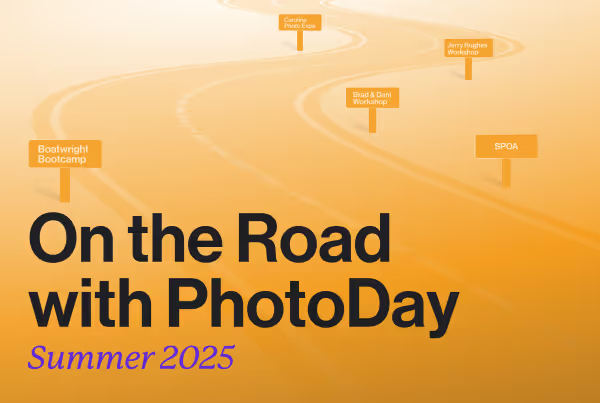You can’t have a great photo without great lighting. While the camera and subject play crucial roles in achieving stunning photographs, it's often the quality of lighting that can make or break an image.
Getting the lighting right isn’t easy, but with experience and practice, you can develop the skills and acquire the necessary equipment. In this blog, we will discuss traditional lighting details, rigs, and techniques, then share a revolutionary lighting setup that will make your next picture day unbelievably simple and efficient.
Why is Lighting Important?
Controlling and manipulating light directly impacts a photograph's emotion, tone, and color accuracy. These factors ultimately determine the image’s quality.
The way you manage lighting matters from both a practical and artistic perspective.
Keeping lighting consistent from the beginning of picture day to the end keeps your subjects visible and sharp. It also speeds post-processing by delivering repeatable images that provide expected results when you apply your presets and extract your images to use with digital backgrounds. Presenting multiple options to prospective customers ultimately leads to more sales.
Artistically, effective lighting sets the mood of the photograph. It creates texture and depth, which is particularly important when using digital backgrounds. Placement and intensity invoke certain feelings in the viewer, directs their gaze, and contours your subject's features, driving visual appeal.
Focusing on your lighting equipment and techniques will ensure you capture the high-quality, desirable images your buyers want.
Soft Light Versus Hard Light
The terms soft and hard light refer to the quality of the light illuminating your subject and how it interacts with them. Photographers must consider the quality of light because it dramatically impacts an image's mood, texture, and style.
Soft light is characterized as gentle and flattering and produces smooth transitions from light to shadow. Large, diffused light sources such as a cloudy sky, softbox, or umbrella create soft tones by spreading and scattering light. In soft light, shadows are less defined, and the details in shadowed areas are more visible. Soft light also minimizes skin imperfections and creates a flattering, even-toned appearance, making it popular in portrait photography.
Conversely, hard light is characterized as direct and intense with well-defined shadows. Direct sunlight, focused spotlights, or an undiffused flash are typical sources of hard light. The harsh lighting makes shadows sharp and dramatic, obscuring textures outside the light. The primary effect of hard light is creating visual drama and emphasizing texture, which viewers and creators of fashion and commercial photography tend to favor.
The Kelvin Scale
The Kelvin scale (also called the color temperature scale) is a fundamental concept for photographers, as it directly influences the color temperature of light, which plays a critical role in the visual impact and quality of photos. It is a standardized measurement used in lighting to describe the color appearance of light sources. Users measure light on a scale of 1000K-10,000K to accurately determine the appearance and ambiance of the light.
Lower temperatures (2000K-3000K) have an orange to yellow hue like the glow of a candle and are considered “warm.” Mid-range temperatures (3100K-4500K) are considered neutral for their white appearance. Light measuring above 4500K will have a bluish tint that mimics daylight and is sometimes classified as “cool.”
The ideal portrait light is in the 5000K-5500K range, equivalent to daylight on the Kelvin scale. You can measure Kelvin using a light meter, but the skin tones of your subjects and the overall quality of your images should indicate if you are staying in the proper range.
Traditional Lighting Setups
Multiple components are necessary to create even, flattering, and consistent lighting at a volume photography location. Good rigs contain three types of lights with different purposes, stands, and equipment for measurement and control.
Your primary light source is typically a large softbox or umbrella angled slightly to the subject to create soft, even lighting and minimize harsh shadows. Next, you will need a fill light that strobes with your shutter or bounces off a diffuser to reduce any shadows the main light creates. Finally, you will need a separation light placed behind the subject to add depth and separate your subject from the backdrop.
Light stands are necessary to hold, direct, and adjust the lights as you want them. They should be heavy enough to keep everything safely in place but not so heavy they make your setup more difficult than it needs to be.
Once you have your lighting in place, you must be able to measure and control its intensity. Using a light meter will help you know how to adjust your camera for properly exposed images. Control equipment like dimmers (usually integrated into your lights) provide an additional control layer.
Before you buy any equipment, check out our gear page. Our partners offer great deals and selection on new and used gear.
Why Light Positioning Matters
Light positioning is an essential component of taking a photograph.
As we’ve discussed, your lighting tremendously impacts the quality of the raw image you are creating. All your light sources must work harmoniously to create texture, shape the subject, and flatter their features and skin tones.
Just as importantly, perfect lighting in your initial image will significantly reduce the time and effort required in post-processing. Using lighting to create a clear delineation between your subject and your background makes extractions like PhotoDay Knockouts crisp and sharp so you can create stunning images with various digital backgrounds.
Additionally, lighting skin tones correctly and flattering a subject's features reduces the need for retouching, ultimately producing a more natural-looking finished image.
Indoor and Outdoor Lighting
Lighting principles are the same whether you are shooting indoors or outdoors. However, you have less control when you shoot outdoors, so you must be prepared to compensate for changing environmental factors.
When shooting outdoors, the sun is generally your main light, so you must position your subjects accordingly. Usually, you will want them to face the sun so you can take advantage of the beautiful natural light. Exceptions might occur if you shoot in the hour after dawn or before dusk, known as the “golden hours.” In this case, you could use a beautiful sunrise or sunset as a dramatic background. No matter the time of day, you may still require additional equipment like reflectors and diffusers to control the amount of light and aim it where you want it to be. If the natural light isn’t favorable, a flash or strobe can enhance the portrait’s lighting to create the depth and contrast you are looking for.
Indoors, you have more control and consistency with ambient light. A traditional three-light setup will be sufficient in most cases. Since volume photographers move from location to location, your goal is to find a repeatable setup that consistently yields the images you expect with minimal adjustment. Take note of your light positions and settings at each location so you can refer to past experiences if you have difficulty lighting a particular site.
One-Light Approach to Indoor Lighting
You can guarantee consistently perfect lighting with every picture you take and significantly reduce your setup time with one easy-to-use system from LVL Up Imaging. The LVL Up Studio System comprises one lightweight, collapsible diffuser screen and two reflector screens that are equally easy to carry and set up. With the screens in place, you only need one light to capture beautiful, powerfully lit images.
Renowned photographers Tom and Mario Muñoz developed the LVL Up System to replicate the control and artistry they could achieve in their studio out in the field.
As Tom explains, “You set this up in literally five minutes, and because your highlight comes from the shadow, you get consistent, three-dimensional lighting without having to change it based on the subject.”
Since actual photographers created and designed the system, it addresses nearly every challenge volume and portrait photographers face.
First, the LVL Up Studio System creates efficiency during setup and teardown. Traditional lighting and backdrops can take an hour or more, but this system goes up in five minutes or less, saving you time and money.
Second, the system provides consistent, softer lighting. Utilizing one light eliminates misfires from additional strobes that necessitate time-consuming retakes.
Third, the LVL Up Studio System's intuitive wall design creates a mini-studio vibe that gives the subject privacy while being photographed, naturally leading to more comfort, better interaction, and better pictures.
Finally, the LVL Up Studio System provides simplicity in the field and during post-processing. From a practical standpoint, it is incredibly simple to learn and use, which minimizes onboarding time for photographers using it for the first time.
During shooting, LVL Up integrates seamlessly with PhotoDay. Our face recognition capabilities eliminate manual check-ins, enabling photographers to interact with students and develop a relaxed atmosphere, which leads to better pictures. The consistent lighting provided by the LVL UP Studio System enables consistent Color Corrections and crisp Knockouts so you can streamline your post-processing and offer multiple backgrounds in your galleries to generate more sales. During checkout, customers can add on our AI retouching which softens skins and removes blemishes.
Improving Your Lighting
Getting lighting right requires education, experience, and practice. You must first understand good lighting techniques before you can execute them. Once you apply the basics, you can branch out and experiment until you find the process that works for you.
Feel free to examine your current setup and consider simplifying it with an open mind. Reducing your rig's complexity will minimize set-up time and significantly reduce onsite mishaps, retakes, and adjustments.
Investing in quality equipment will provide your studio with consistent results and make it easier to scale your business over time. If your team is experiencing difficulty getting repeatable, consistent lighting from location to location, the LVL Up system could be an excellent investment for your studio.
In photography, lighting is everything. For volume photographers, well-controlled light creates efficiencies from picture day through post-processing. It takes a good eye to get it right, but it also requires good equipment and solid technique. If you haven’t quite got it down yet, you will. Start with the basics and keep building your skills. Before you know it, you’ll capture balanced, perfectly lit images every time.








